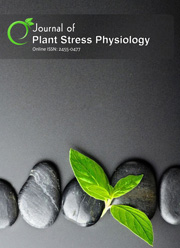Growth and total photosynthetic pigment responses of five accessions of Zea mays L. grown under waterlogging stress
DOI:
https://doi.org/10.25081/jpsp.2023.v9.8659Keywords:
Adventitious roots system, Photosynthetic pigment, Waterlogging, Zea maysAbstract
The effect of waterlogging on the growth of five accessions of Zea mays was investigated. The growth parameters, evaluated from 2 WAP (Weeks after planting) included: leaf area, number of nodes, total photosynthetic pigment (TPP) as well as plant height. Results revealed that TZM-4 (7.00±0.296 cm) showed a higher growth under waterlogging stress as observed in shoot length, whilst TZM-5 recorded the lowest growth with (4.83±0.17 cm). Results for the estimation of the total photosynthetic pigment; TZM-4 was observed to have retained a high value (28.23±8.63 mg/kg), while TZM-1 showed the lowest value (15.33±3.23 mg/kg) after 4WAP. For the number of nodes, TZM-1 recorded a high value (4.67±4.67), while TZM-5 had the lowest value (2.33±1.20). By observation, TZM-5 showed a better overall waterlogging tolerance which could be attributed to the development of adventitious roots which aided aeration. Hence, waterlogging stress had negative effects on the growth and TPP of Z. mays. However, TZM-5 showed promising advantage under waterlogging condition while TZM-3 showed poor tolerance in growth rate which makes it a non-favorable choice for planting in waterlogged soil. Thus, this research provides a promising insight for breeders and plant scientists to capitalize on for the breeding of this very important economic crop for sustainable agriculture and food security in a world threatened by climate change.
Downloads
References
Bray, R. H., & Kurtz, L. T. (1945). Determination of Total Organic and Available Forms of Phosphorus in Soils. Soil Science, 59(1), 39-45. https://doi.org/10.1097/00010694-194501000-00006
Davies, C. L., Turner, D. W., & Dracup, M. (2000). Yellow lupin (Lupinus luteus) tolerates waterlogging better than narrow-leafed lupin (L. angustifolius): II. Leaf gas exchange, plant water status, and nitrogen accumulation. Australian Journal of Agricultural Resources, 51(6), 711-719. https://doi.org/10.1071/AR99074
Hanna, W. J. (1964). Methods for chemical analysis of soils. In F. E. Bear (Eds.), Chemistry of the Soil New York, USA: Reinhold Publishing Corporation.
Jackson, M. B., & Drew, M. (1984). Effects of flooding on growth and metabolism of herbaceous plants. In T. T. Kozlowski (Eds.), Flooding and Plant Growth (pp. 47-128) Orlando, Florida: Academic Press Inc.
Mabhaudhi, T., & Modi, A. T. (2011). Can hydro-priming improve germination vigour, speed and emergence of maize landraces under water stress? Journal of Agricultural Science and Technology, 1, 20-28.
Malik, A. I., Colmer, T. D., Lambers, H., & Schortemeyer, M. (2001). Changes in physiological and morphological traits of roots and shoots of wheat in response to different depths of water logging. Australian Journal of Plant Physiology, 28(11), 1121-1131. https://doi.org/10.1071/PP01089
Malik, A. I., Colmer, T. D., Lambers, H., Setter, T. L., & Schortemeyer, M. (2002). Short-term waterlogging has long-term effects on the growth and physiology wheat. New Phytologist, 153(2), 225-236. https://doi.org/10.1046/j.0028-646X.2001.00318.x
Manik, S. M. N., Pengilley, G., Dean, G., Field, B., Shabala, S., & Zhou, M. (2019). Soil and crop management practices to minimize the impact of waterlogging on crop productivity. Frontiers in Plant Science, 10, 140. https://doi.org/10.3389/fpls.2019.00140
Shabala, S. (2011). Physiological and cellular aspects of phytotoxicity tolerance in plants: the role of membrane transporters and implications for crop breeding for waterlogging tolerance. New Phytologist, 190(2), 289-298. https://doi.org/10.1111/j.1469-8137.2010.03575.x
Sinefu, F. (2011). Bambara groundnut response to controlled environment and planting date associated water stress. MSc. Thesis, University of Kwazulu-Natal.
Visser, E. J. W., & Voesenek, L. A. C. J. (2005). Acclimation to soil flooding-sensing and signal-transduction. Plant and Soil, 274, 197-214. https://doi.org/10.1007/s11104-004-1650-0
Published
How to Cite
Issue
Section
Copyright (c) 2023 Journal of Plant Stress Physiology

This work is licensed under a Creative Commons Attribution 4.0 International License.



 .
.